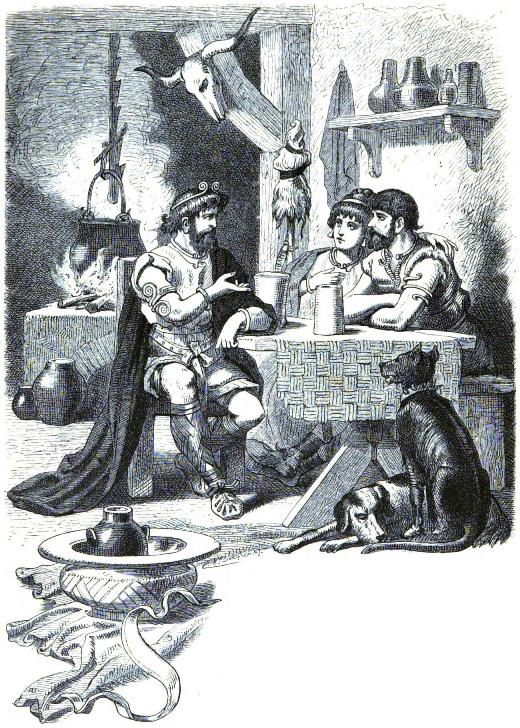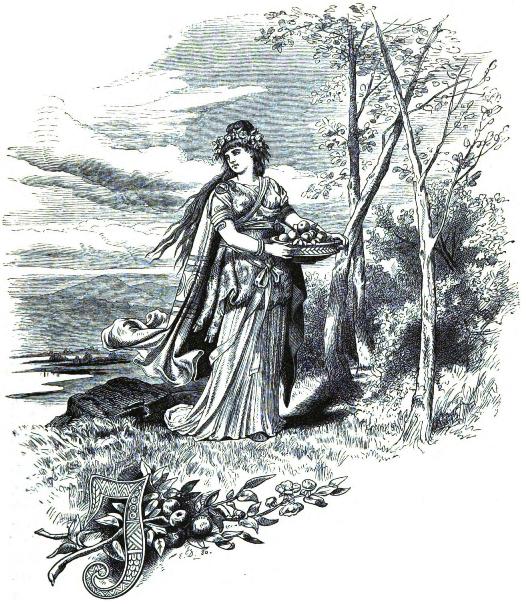March Lesson
This month we will read about Heimdall and Idun.
Heimdall establishes the social classes of men
In the beginning Heimdall walked the Earth and called himself Rig. He walked far and wide, to places seldom visited by anyone.
During his first journey he found a hut where a gray-haired couple sat by the fireplace. The man was called Ae and the woman was called Edda. They gave him bread and veal soup to eat, and he shared their bed for three nights. Nine months later Edda gave birth to the son Träl (“slave”). When he grew up his back became bent and the skin on his hands became wizened. They saw that he was very strong and could carry very heavy things. One day, a young woman visited them. Her name was Tir (“maidservant”), her arms were sunburnt and the soles of her feet were scarred. They got married, worked hard every day, and had many children. Their children had names like “sooty”, “clumsy”, “ugly”, “mute”, “cheeky” and “rag-clad”. The children worked alongside their parents; building fences, bringing up pigs, herding goats and digging peat. All slaves and serfs are the descendants of Träl and Tir.
During the second journey of Rig he found a farm where a well-dressed and well-groomed couple sat by the fireplace. The man was called Afe and he was carving a wooden weaver’s beam. The woman was called Amma and she was spinning thread for mending clothes. Rig stayed with them for three nights. Nine months later Amma gave birth to the son Karl (“man”). He had red hair and lively eyes, and when he grew up they found that he was skilled at taming ox, building tools for the farm, building houses, barns and carriages, and plowing. One day, they invited the young woman Snör (“cord”). She carried keys in her belt. Karl and Snör got married and had many children. Their children had names like “farmhand”, “freeborn”, “blacksmith”, “farmer”, “talkative”, “pretty”, “serious”, “wife” and “seamstress”. All farmers are descendants of Karl and Snör.
During the third journey of Rig he found a big house where a rich couple was working. The man, Fader (“father”), was twisting a bowstring and the woman, Moder (“mother”), was ironing clothes. They gave Rig thin wheatbread, pork and fried birds to eat, served on silver plates. Rig stayed with them for three nights. Nine months later Moder gave birth to the son Jarl (“jarl/ruler”). He had fair hair, rosy cheeks and sharp eyes. When he grew up he learned how to use a lance and a sword, twist bowstrings and use a bow and arrows, throw a spear, ride a horse, hunt and swim.
One day when Rig was travelling he met Jarl on the road and liked him. Rig taught him the secrets of runes (knowledge, skills, writing skill, magic symbols) and was so happy with Jarl’s progress that he let him use Rig as his family name. Jarl left and happened upon a castle. He started a war with weapons and killed many men. Finally he had won eighteen farms and led many men. He shared his wealth with his subjects, giving them estates and horses. Jarl sent word to another castle where the young and beautiful woman Erna (“brisk”) lived. She was impressed by Jarl’s achievements, and Jarl was taken by her beauty, and they got married and had many children. Their children had names like “child”, “born”, “noble-born”, “descendant” and “king”. They played games and learned how to swim, ride a horse and use weapons. The youngest son, Kon (“king”), also studied the runes. With the help of runes he learned how to stop weapons, calm the seas and the fire, understand the language of birds and still sorrow. One day Kon was hunting birds with blunt arrows, and a crow scolded him, saying that he should kill warrior men rather than birds, and that a king was more highly regarded if he behaved manly in battle. Kon took the crow’s advice to heart and changed his name to Konung (“king/ruler”). All monarchs are descendants of Jarl and Erna.

Idun and her golden apples are abducted
Odin, Loki and Hoener were travelling and one evening they were roasting an ox on the open fire. But no matter how long they roasted it, it never got ready to eat. Then they noticed a huge eagle sitting in a tree, and the eagle told them he was the one causing the ox to not finish roasting. He asked them to share the ox with him. They agreed, but then the eagle ate both hindlegs and both shoulders of the ox, and Loki thought he was very impudent for eating so much. Loki grabbed a large stick and hit the eagle – but the stick got stuck in the eagle’s body and Loki couldn’t let go of the stick, so when the eagle flew away Loki was dragged along. Loki feared for his life, but the eagle said he would spare him if he lured Idun outside of Asgard together with her golden apples. Loki agreed and could join Odin and Hoener again.
Idun’s golden apples were very special. Anyone who took a bite of them remained forever young and didn’t age. Loki told her a lie about some other special apples he found, and asked her to bring her own apples to compare them. Idun didn’t suspect anything but went with him. As soon as she entered the woods outside of Asgard, the giant Thjazi in the shape of an eagle grabbed her and brought her to his home Thrymheim. As soon as Idun and her golden apples were lost to the gods in Asgard, they grew old and gray-haired.
The gods met and figured out that Loki was the last person to be seen together with Idun, so they seized him and threatened to kill him if he didn’t get her back. Loki borrowed Freya’s falcon guise and flew to Thrymheim. Thjazi was out on the lake, so Loki turned Idun into a nut, gripped her with his talons and returned to Asgard. But when Thjazi returned and noticed that Idun was missing, he turned into an eagle and set off looking for her. He noticed a falcon that flew very quickly towards Asgard and started hunting it. Soon, Thjazi the eagle had caught up with Loki the falcon. They were so close to Asgard now that the gods saw what was happening, and they rushed to the walls of Asgard. Right after Loki flew over the wall they lit a huge fire, and Thjazi flew so fast that he couldn’t turn around but flew straight into the fire and burnt his wings so badly that he fell to the ground where the gods killed him.
The gods were happy that Idun was brought back to them (and her golden apples), and Thjazi’s daughter Skadi married Njord in conciliation.

Sources:
Stora boken om vikingarnas gudar och myter by Lars Magnar Enoksen (ISBN 978-91-7738-792-3)